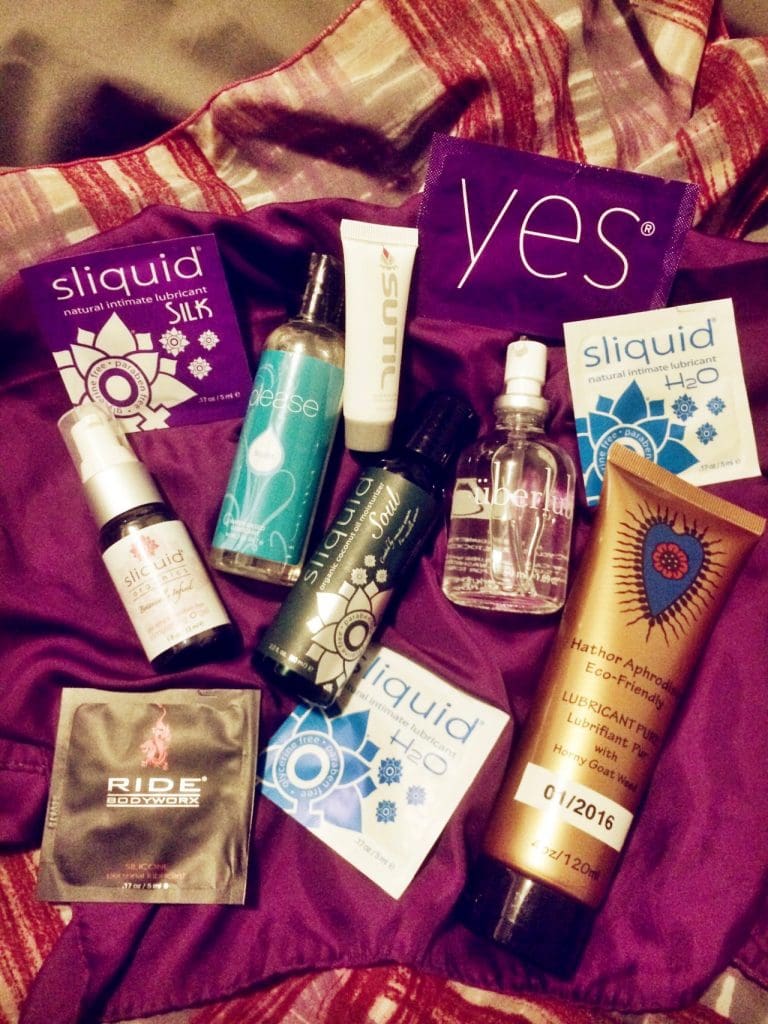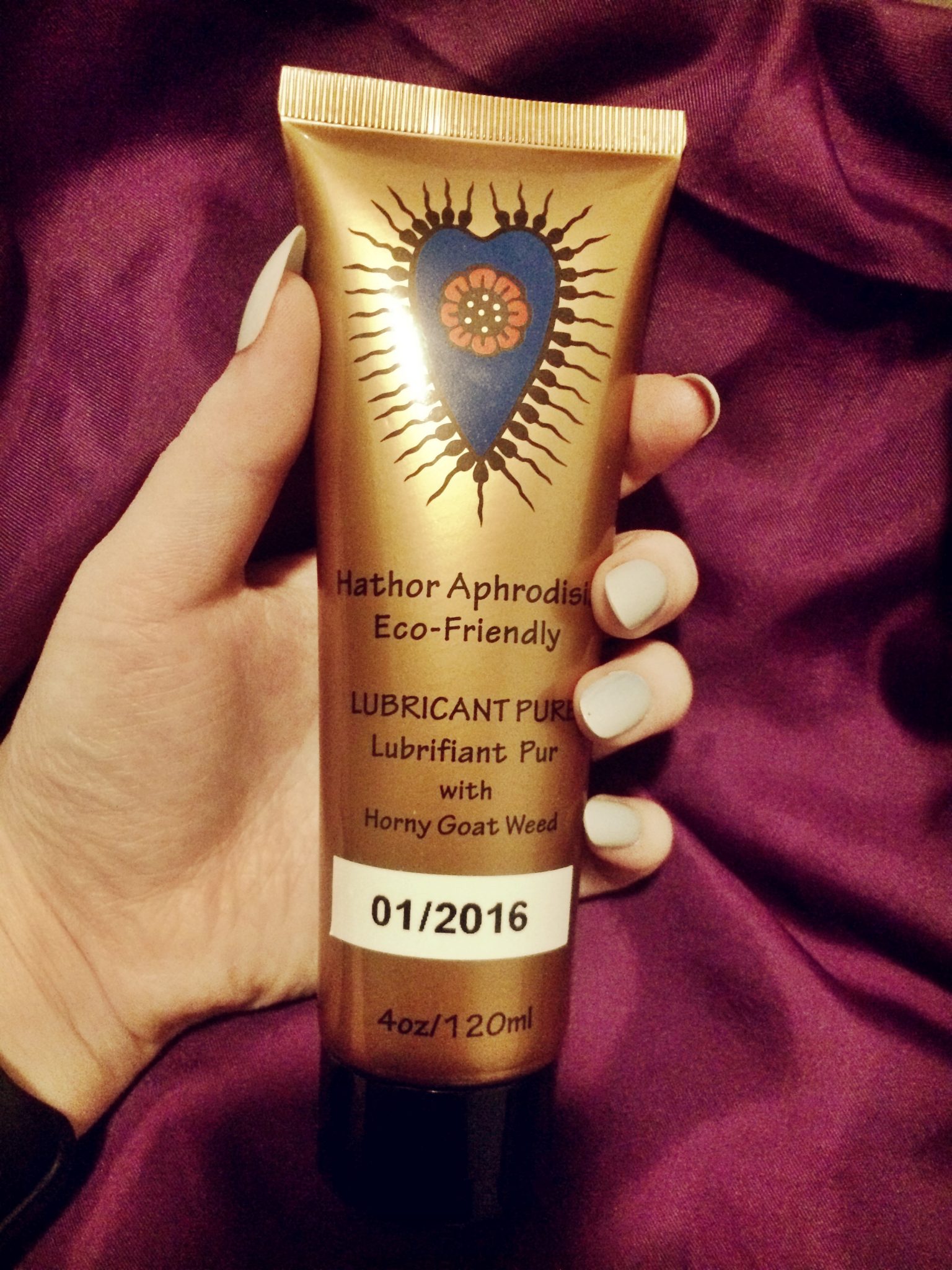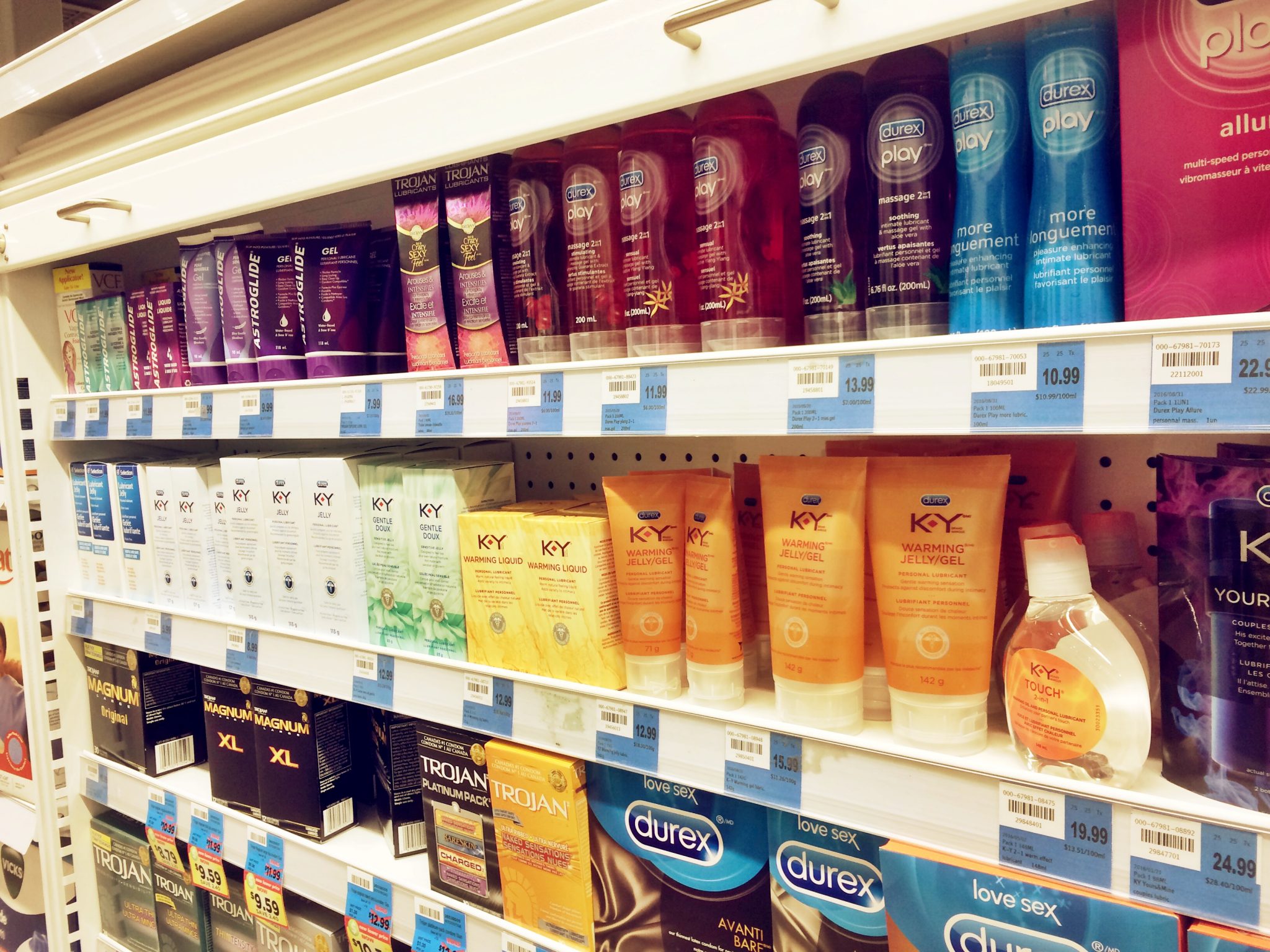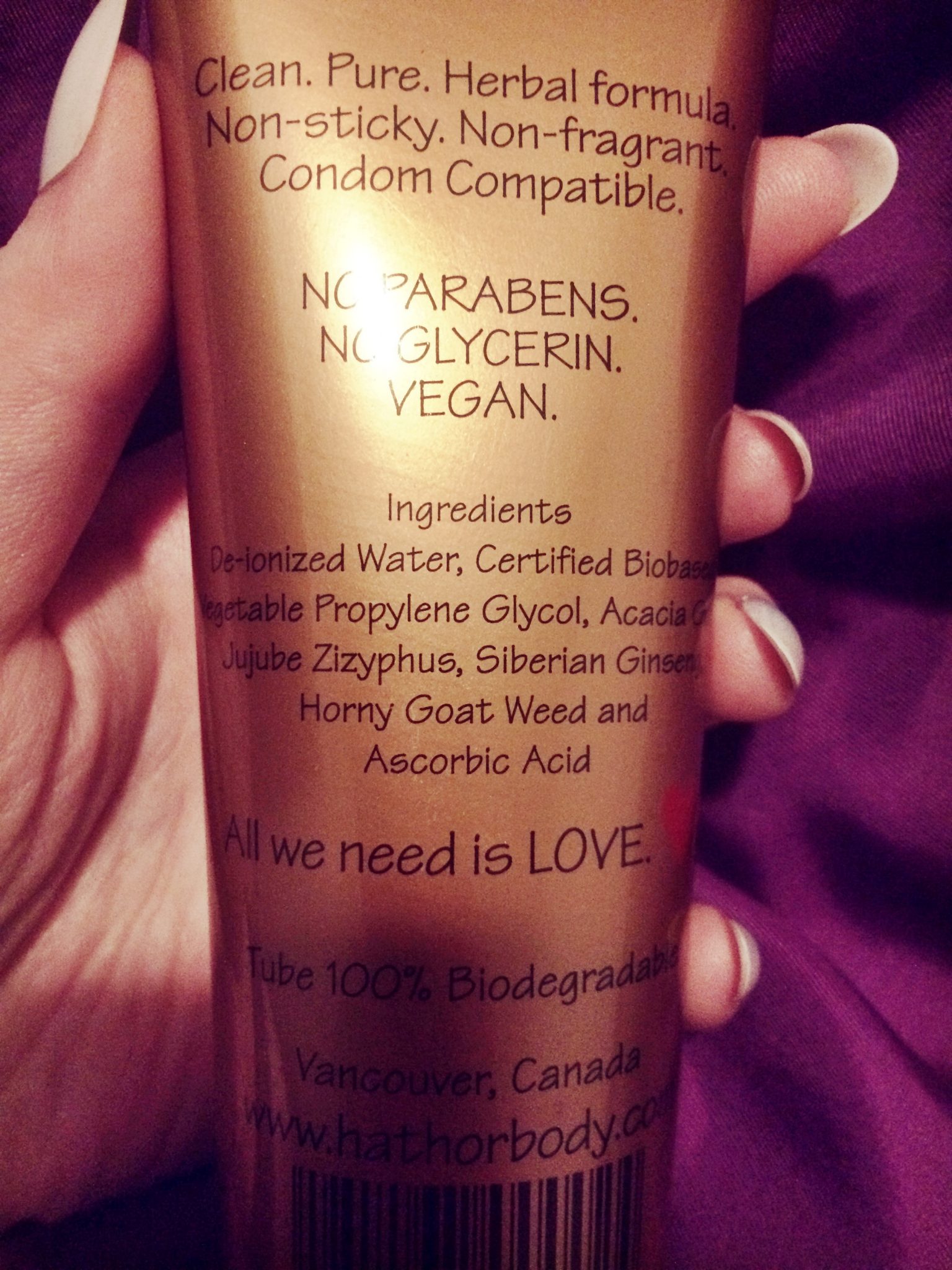You’ll probably never see me write a complete review for a lubricant. Why not? I just don’t have a whole lot to say – it either works well for me or it doesn’t. On top of that, when I find a lube that I like, I buy the biggest bottle of it so that I always have it on-hand. This means I’m not trying out lots of different lubes. Basically the only time I use something new is if I wind up with a sample when I get a new toy or go to an event with swag bags, and I take those samples traveling with me.

What I can do is tell you which lubes I like and don’t like so far, but that list is still laughably short. Ready? Here goes…
I like Hathor Aphrodisia by Hathor Body, and their other product line SUTIL
I don’t mind Sliquid https://twitter.com/tinahornsass/status/933054521609195520
I don’t like Good Clean Love (it burned me, likely because of the Aloe) or Fuckwater (once in a while is alright but it threw off my chemistry after too frequent use)
I don’t like just about everything you’ll find on your drugstore shelf
Yep…that about covers it.
My personal lube story is fairly short. I almost never used lubricant until sometime in the last 2.5 years when I started actually using dildos on the regular. The first lube I bought was a waterbased lube called Fuckwater, and if we’re honest I bought it half because it’s got a great name, and half because after 15 minutes of rubbing lube samples between my fingers at Come As You Are and using up a whole box of tissues to wipe myself off, I decided I liked the feel of Fuckwater best.
Turns out that if I used Fuckwater more than once a week however, it threw off the balance of the little ecosystem living in my vagina. I didn’t experience any intense irritation like many other lubes will cause, but my discharge would become excessive and weird. I’m already naturally on the heavier end of the discharge spectrum, so adding any more moisture to my genitals and subsequently my underwear and tight jeans is just a bad idea. It’s uncomfortable to walk around all day in for one thing, but it also poses a higher risk for yeast infections.
On my next trip to Come As You Are, I read up on the ingredients a bit more and settled on a few samples instead of bringing home more full-sized bottles that may or may not ever get used (my Fuckwater bottle is more than half-full.) After some tests I decided the next time I went in I would pick up a bottle of Hathor Aphrodisia and snag a couple tiny sample-sized Sutil bottles for when I’m on the go, and that’s what I’ve been using ever since.

My kGoal came with a sample packet of Good Clean Love water based lube and, for the first time using lube, I did have an immediate reaction. As it so happens, some people are sensitive to aloe. In my case, it’s apparently only when applied to my genitals, as I have no issues using Aloe Vera gel on sunburns and I have no problems eating aloe’s food cousins – garlic and onions. Still, the moment I applied the lube to my vulva there was a distinct stinging sensation. It didn’t last too long, so I was able to wait it out for a moment and then proceed to use my toy without further issue, but it was enough to dissuade me from using the lube again.
I haven’t had enough experience with Sliquid lubes to form a solid opinion on them, and there are also MANY kinds to choose from within the Sliquid family. So far I haven’t had any adverse reactions to what I’ve tried, but I’ve also stayed away from the ones that contain aloe (this is true for other companies as well.)
All of these lubes work just fine for a lot of people. That a lube disagrees with my body has absolutely no bearing on what it will do for you, which is another reason I’m hesitant to write reviews. Lubes are even more subjective than vibrators and dildos. I can tell you that if you don’t like too much texture in your sex toys, which ones you should avoid, but I have absolutely no idea what the chemical makeup of your genitals is like so I can’t possibly tell you what will feel good or what might not – among good lubes.
I CAN tell you what you want to avoid in bad lubes, so that’s what the rest of this post will be about.

The vast majority of what you’ll find on your drugstore shelf, grocery store shelf, and even a lot of sex shop shelves is going to be utter garbage and you should not use it if you don’t have to. I recognize that not everyone has amazing sex stores near them that actually do research and care about what happens to their customer’s bodies when they use products bought at that shop, so I understand that not everyone will have access to amazing lubes all the time. If this is you I do recommend trying to find them online if that’s an option for you because seriously, good lube is a big deal. (Target seems to stock Good Clean Love now, and even though it doesn’t work for me, it does work fine for a lot of others, so if you’re really in a bind for where to get good lube I recommend giving it a shot)
First of all, an FDA approval on lube is not a stamp saying “THIS IS GOOD FOR YOU”. An FDA approval means it’s non-toxic. Non-toxic means it won’t outright kill you, not that it won’t hurt you. Lemon juice is non-toxic but if I soak my hand in it for hours on end, eventually my skin will be less than pleased with me. FDA testing is also generally not done on human parts, and certainly not the human parts that the product is actually going to come into contact with. The eyeballs of rabbits are nothing like a human vulva, and yet that is what we base our safety tests on? In short : don’t rely on FDA approvals.
Also, this should go without saying but avoid known allergies/sensitivities. If you are one of those people who knows they have an aloe sensitivity, don’t think you wont react to a lubricant that has aloe in it. The skin on your genitals is some of the most sensitive skin you have, if you can’t put aloe on your arm you definitely shouldn’t give it a test run inside your vagina. Aloe is just one of the many many ingredients used in lube that people can have allergies or sensitivities to and I mention it so much only because it’s what I’m experienced in, the aloe sensitivity is actually pretty rare all things considered. There’s the whole list I’m about to give you for “chemicals” you’ll want to be wary of but you also need to be careful of the more “natural” and “organic” lubes if you have sensitivities to certain plants (some lubes use nut oils and extracts) and herbs. A lot of us won’t know we have a sensitivity until we try something with that ingredient in it, so if you have the ability to do so I highly recommend getting the smallest bottles or samples if they’re available. I’d be pretty upset if I’d bought a giant bottle of Good Clean Love only to find out afterwards that I can’t comfortably use it.
When it comes to picking a lube you have three different “base” options to choose from : Water based, Silicone based, and Oil based (there’s also a “hybrid” of water and silicone but the collective “we” don’t know very much about it and I personally have zero experience with it, so I won’t be talking about it.)
Oils are great, long-lasting lubes because they just don’t dry out and soak in as quickly as water based lubes do. The problems with oils are that they degrade latex and poly-isoprene barriers, so if you’re using a barrier it needs to be made of poly-urethane or nitrile (not as readily available as latex.) Oil is fine on non-porous sex toys (silicone, metal, glass, ABS plastic) but not good for porous materials (which we don’t want you to be using anyway.)
If you’re using an oil it should be plant based if possible, as petroleum based oils are generally not great for your body (it’s petrol, petroleum jelly is a waste product of oil drilling, it was literally discovered because it was annoyingly collecting and gumming up the works on 1850’s oil rigs and the workers started rubbing all the gunk they scraped off their machines into their dry skin. As a topical treatment it has some uses on certain non-mucous membrane parts of your body, but it is not really here for your genitals) and can trap and promote bacteria growth.
Most people using oils are on a coconut oil craze right now (“organic cold-pressed” , “virgin” , “unrefined.”) which is just fine, most people except those with a sensitivity to coconut will have no issues with using it for a lube. People with already oily skin may experience some pore-clogging, so maybe do just a little patch test before bathing yourself in it. On the other hand, a lot of people do quite literally bathe in it, so it just depends on what your skin type is like. Coconut oil is said to do the opposite of petroleum oils and have good anti-bacterial properties that mesh well with a lot of people’s genitals. It will stain your bed sheets though, and if you spill it on your hardwood/tile floors…good luck. You can just grab a jar at your grocery store or you can pick up some branded-for-sex versions online and at sex shops. If you buy it at the grocery store it will probably be solid, but it melts at body temp very quickly. Sex shops usually sell them in liquid states.
Oil based lubes will eventually go rancid, but you’ll absolutely be able to smell it when they do.
Silicone is another great option if you find your lube drying out too quickly. Silicone typically comes with very few ingredients so they’re pretty easy to check up on, and by nature is already hypoallergenic – provided the manufacturer doesn’t throw in additional ingredients that you are sensitive to, but that doesn’t happen often. There is a very small chance that silicone lube left around the urethra can trap bacteria and cause UTIs but unless you’re someone who suffers from UTIs chronically the likelihood of this being a problem is very low.
Silicone lube is sometimes compatible with silicone sex toys, sometimes not. It really depends on the quality of both the lube and the toy. Silicone lube that is not compatible with a silicone toy doesn’t utterly destroy the toy, but it does often make the surface of the toy feel sticky or rougher. Your toy is still safe and non-porous, it’s just not as nice as it used to be, so we like to avoid these issues. A number of toy makers and lube manufacturers are teaming up these days to bust the myth that you can never use silicone on silicone, so if you see a company say they’ve tested their toys with another company’s lube you can bet those two are safe to use together. If you’re unsure, do a patch test somewhere on the base of the toy or where it will be least noticeable/impactful to the use of the toy. Reactions will happen within a few minutes, so if you wipe the lube off and nothing has changed, you’re good to go. Silicone is just fine for other non-porous materials as well.
Silicone is just fine to use with all types of barriers, and it never expires.
Water based lubes are the most complicated, and this is unfortunate because they are also the most widely used and readily available lubes out there. To find a good quality water based lube that is least likely to cause you irritation, you need to get a little sciencey, or at least go to the store with a list of things you want to avoid. Hold onto your butts, this is about to get ridiculous.
Water based lubes can be described as either hypo-osmotic, iso-osmotic, or hyper-osmotic. Osmolality is a fancy term to describe the pressure of a liquid – in this case it’s water. Picture a drop of lube rubbing up against one of your skin cells. Both of these things have their own water content, both of these things have their own water pressure, and in an ideal situation those pressures match, so the lube and skin cell share that water between each other in a balanced way.
In hypo-osmotic lubes, the water pressure in the lube is lower than that of your skin cells, which means it’s sharing more water with your skin cell than the cell is pushing back out. This causes your skin cell to inflate until it ruptures, and then it dies as a result. Obviously this is bad news for your skin cells, and this is one of the causes for irritation in and on your genitals. Hypo-osmotic lubes are also bad if you’re actively trying to conceive, because in addition to bursting your skin cells, they inflate and burst sperm cells as well.
Hyper-osmotic lubes do the opposite, which is to say that the pressure of a hyper-osmotic lube is higher than the skin cell, and it will essentially suck your skin cell dry and leave it to die again. Hyper-osmotic lubes are the vast majority of irritating lubes on the market. That burning and itching and literal dryness you’re experiencing is due to your skin cells drying up and sloughing off. Delightful huh? To give you a bit of a visual, vaginal skin cell osmolality is around 280 mOsm/kg. Even if you have no idea what that means, when you remember that skin cells are trying to strike a water pressure balance with lube, I think you can understand the impact it has when KY warming jelly is ranked as 10,300 mOsm/kg. The lube simply obliterates your skin cells. KY warming jelly is perhaps one of the worst examples we have – there are plenty of lubes that are not nearly this bad – but it serves to both drive the point home that this isn’t something to scoff at, and to back up the assertion that some of the most popular or well-known products are terrible, everyone’s heard of KY before right? You’d think something so popular would be safe, right?
It’s tough to find a lube that is perfectly iso-osmotic (has the same water pressure as your skin cells) because everyone’s skin will be a bit different, from other people’s and from your own skin at different times in your life or in different parts of your body (vagina or anus.) Avoiding certain ingredients can get us into the “good enough” range where most people won’t experience too much irritation, however we still need to be careful, just because there’s no apparent irritation still doesn’t make the lube perfectly “safe.” All this cell death, whether they’re overinflated or shrivelled up, makes us more susceptible to STI transmission.
Ingredients you want to try to avoid:
Glycerin – can trigger yeast infections in vaginas, still not safe for anuses because it also affects osmolality.
Propylene Glycol – is a sensitizer, meaning the more you use it, the higher a chance there is that you develop a reaction to it. Allergic reactions to propylene glycol are usually inflamed dry skin and rashes.
Nonoxnyl 9 – was originally developed with the intent to kill infectious bacteria and stop the spread of STIs. The problem is it kills the good bacteria in your genitals as well, disrupting the environment which leads to more infections.
Chlorhexidine Gluconate – also developed as an antiseptic meant to kill everything. It was intended for extreme situations like risky surgical applications, not for personal lubricant.
Polyquaternium 15 – known to release formaldehyde and cause allergic reactions.
Benzocaines and Lidocaines – numbing agents (which you do not need, pain his how your body tells you that you’re doing something wrong!) known to cause allergic reactions.
Sugars (glucose, maltodextrin, honey, essential oils, etc) – cause yeast infections. Most flavoured lubes are NOT meant for vaginal sex, they are meant to make ORAL sex more pleasurable. Stevia is a safe natural sweetener if you’re looking for something that tastes good but can still be used in the vagina.
These are sort of the “big baddies” that stand out the most when we’re talking about what’s in our lube that is screwing us up. Other things you want to try to look out for are other preservatives (parabens, citric acid, sodium hydroxide, potassium sorbate, benzyl alcohol) other surfactants (glycols, sulfates, PEGs) and as I pointed out earlier when discussing oil based lubes, petrochemicals (butylene glycol, ethylenes, petroleum, mineral oils)
And again, anything else you know you have an allergy or sensitivity to.
These ingredients are bad for you for the reasons listed next to them, but they also play a role in the overall osmolality of the lube, so even if – for example – you’re not using your lube in a vagina so a yeast infection is not an issue, you still want to avoid a lube with glycerin in it because the glycerin is causing a too high or too low osmolality for the parts you are applying it to.
What are these things doing in your lube? Preservatives, mostly, and a lot of them are completely unneeded. These unsafe lubricant’s formulas are largely being based off of the formulas for only slightly similar other products like lotions, soaps, topical treatments and cosmetics, so there’s a ton of ingredient function redundancy. It’s not at all uncommon to pick up a bottle of drug store lube and find 7 different preservatives in it. Is that really necessary? Absolutely not, but they’re in there because nobody bothered to look at the formula and go “oh hey, already got something in here to do that job, we can nix these other 6 chemicals then” and proceed to reformulate before product release.
Some are also used to create warming or tingly sensations, but when you remember that these chemicals are killing your skin cells, you’ll realize that “warming” is actually a milder version of burning, because your skin is dying or having a bad reaction. This is why some people have had extremely horrible experiences with these gimmicky lubes, a big part of the reason KY Warming Jelly is such a recognizable name is because we all have at least one friend with a story about how they nearly went to the ER with their crotch feeling like it was on fire (and yet, for some reason, people still try this stuff.)
But wait, this gets even more tricky. On top of the osmolality of lubes, we also have to consider the pH of the lube and how it relates to the pH of our genitals. All of those ingredients above that affect osmolality play a second role in pH balance. Typically if you find your lube is burning you, that means it’s pH is too acidic. If your lube is making you itch, it’s probably too basic.
Everyone’s genital pH is going to be a bit different, and it changes based on age and hormone levels. Medical professionals describe a “healthy vaginal pH” to be anywhere from 3.5 to a 7, so what works for your best friend might feel awful for you, and the lube you’ve been using without a hitch since you were 20 may suddenly bother you in your 40’s or if you’ve recently gone on or off a hormonal medication. We should also remember for those of us engaging in anal play, that the rectum has a completely different ecosystem and pH level than the vagina (usually a 6), so if you have both, the lube that works for your vagina may irritate your anus (or vice versa.)
Water based lube does have a limited shelf-life, somewhere between 5-10 years. Most people won’t keep their lube around that long, because they use it up or it starts to change consistency. If you do happen to hold onto some for quite a while, you should know that the pH of water based lube rises as it ages, so again if it worked okay 5 years ago but it hurts now, throw it out.
Finally, we need to be careful with lubes that are “replenishing” or “restoring” – these are not every-day lubes, these are specifically for when you’ve had something happen that definitely threw off your genital’s balance and it actually needs fixing (a round of strong antibiotics for example, or after using a lube on the other end of the spectrum intended to boost conception) Just like we don’t need to douche because the vagina cleans itself, it also does a pretty okay job of regulating the pH and yeast levels so it does not need to be, and should not be constantly “replenished.”
We can’t just look at a bottle of lube and magically know what the pH and osmolality is, but it’s a good bet that if it contains a whole bunch of those chemicals I listed to avoid, then it probably won’t match up very well with your genitals.
This gets even harder when lubes with good pH have bad osmolalities, or ones with good osmolalities have a pH off the charts in either direction. Astroglide has a horrible osmolality level but the pH isn’t too bad. One of Sliquid’s lubes has an osmolality almost 200 points below vaginal membranes but the pH is in a 6 range which lines up perfectly with lots of vaginas. The osmolality vs pH factor is a bit of give and take, we try to find one that’s pretty good on one factor, and good enough on the other.
At the end of the day, it comes down to what’s irritating to you. If you have a lube that has never caused you any trouble and you don’t mind using it, then go ahead and use it. If however, you’ve had bad experiences when using lubes or you’re in the market for a brand new one, then these are things you may wish to consider when purchasing. If you’re having sex that puts you at risk for STIs, you may be more concerned if your lube is going to amp up that risk.
In my case, Sutil has citric acid in it, but I’ve never had a bad reaction when using it and given the option of one bad ingredient that doesn’t actually irritate me, and 20 bad ingredients in the things I can buy at Walgreens that will set my junk alight, I opt for the former. I haven’t found any ingredients in Sutil’s sister Hathor Aphrodisia that are bothersome either.

I may update my list at the top as I try out more lubes but I imagine it will not happen with any sort of great frequency, I don’t really feel like potentially hurting my vagina just in order to review things if I have a perfectly good big bottle of lube I actually like at my fingertips.
For more lubey info you should head to Dangerous Lilly’s Big Lube Guide , and if you want to geek out harder you could check out one of Smitten Kitten’s hosted Lube Webinars by Sarah E Mueller